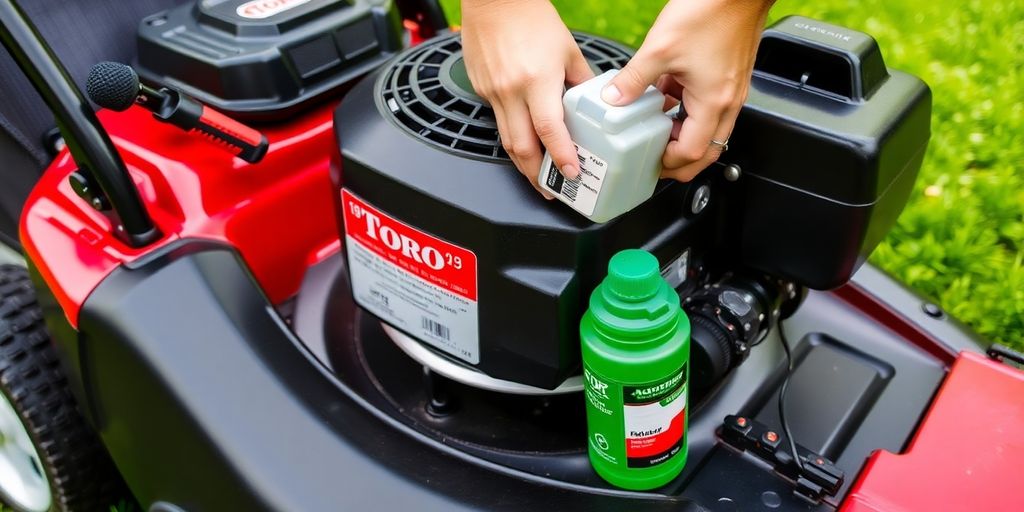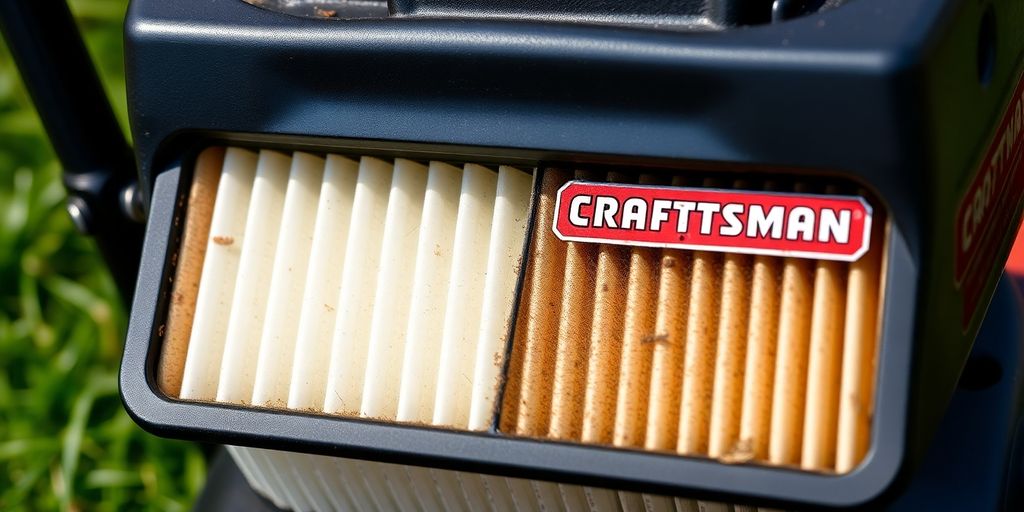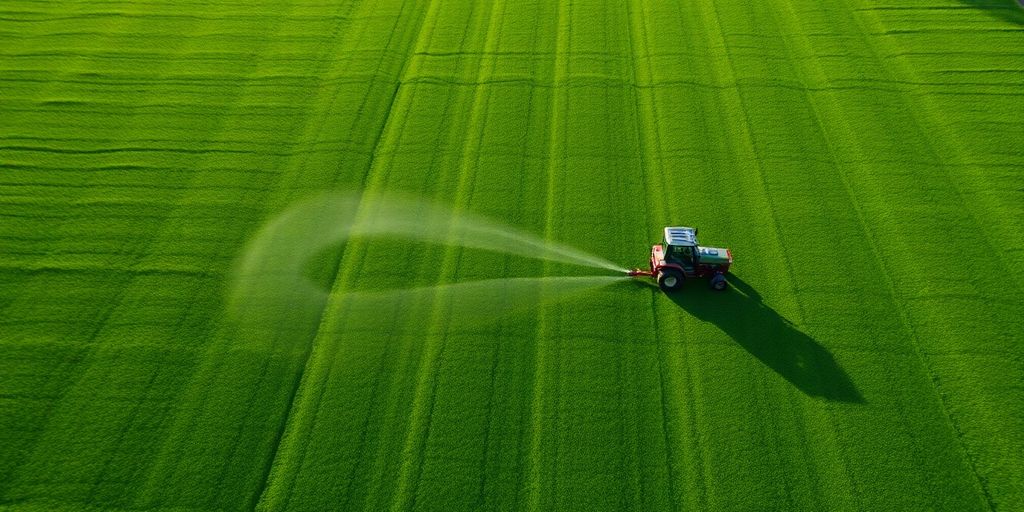Changing the oil in your Toro lawn mower is a key part of keeping it running smoothly. Regular oil changes not only help your mower last longer, but they also ensure it performs at its best. If you want to save money and learn a new skill, this guide will walk you through each step of the process. Get ready to roll up your sleeves and give your mower the care it deserves!
Key Takeaways
- Regular oil changes keep your Toro lawn mower running efficiently.
- Look for signs like dark oil or engine noise to know when to change oil.
- Gather the right tools and oil type before starting the job.
- Always follow safety precautions, like letting the engine cool down.
- Keep a maintenance record to track your oil changes and other upkeep.
Understanding The Importance Of Oil Changes
Benefits Of Regular Oil Changes
Okay, so why bother changing the oil in your Toro lawn mower? Well, think of it like this: your mower’s engine is working hard, and the oil is what keeps everything running smoothly. Regular oil changes are super important for keeping your mower in good shape.
Here’s a few reasons why:
- Extends Engine Life: Clean oil reduces friction, which means less wear and tear on the engine parts. This can seriously extend the life of your mower.
- Improves Performance: Fresh oil helps the engine run cooler and more efficiently. You’ll notice a difference in how smoothly your mower operates.
- Prevents Costly Repairs: Neglecting oil changes can lead to major engine problems down the road. A little maintenance now can save you a lot of money later. Make sure you change the engine oil regularly.
Skipping oil changes is like skipping doctor’s appointments for your mower. You might get away with it for a while, but eventually, something’s gonna break down. Regular maintenance is key to keeping your machine healthy and happy.
Signs Your Oil Needs Changing
How do you know when it’s time for an oil change? Here are some telltale signs:
- Dirty Oil: Check the oil level using the dipstick. If the oil looks dark, sludgy, or has particles in it, it’s time for a change.
- Engine Noise: If your mower is making unusual noises, like knocking or rattling, it could be a sign of low or dirty oil.
- Reduced Performance: Is your mower struggling to cut through grass, or does it seem less powerful than usual? This could be due to old oil not lubricating properly.
- Hours of Use: As a general rule, change the oil after every 25 to 50 hours of use, or at least once a year. Check your owner’s manual for specific recommendations.
Impact On Mower Performance
Let’s be real, nobody wants a lawn mower that’s constantly breaking down. Old, dirty oil can seriously impact your mower’s performance. It can lead to:
- Overheating: Dirty oil doesn’t dissipate heat as well, which can cause the engine to overheat.
- Engine Damage: Lack of lubrication can cause parts to grind against each other, leading to serious engine damage.
- Poor Fuel Efficiency: A struggling engine uses more fuel, costing you money in the long run.
| Issue | Impact |
|---|---|
| Dirty Oil | Reduced lubrication, increased friction |
| Overheating | Potential engine damage |
| Poor Performance | Difficulty cutting, reduced power |
| Reduced Lifespan | Premature wear and tear on engine components |
Gathering Necessary Tools And Materials
Okay, so you’re ready to change the oil in your Toro lawn mower. Awesome! But before you get your hands dirty, you’ll need to gather all the right stuff. Trust me, having everything ready beforehand will make the whole process way smoother. I can’t tell you how many times I’ve started a project only to realize I’m missing a key tool. Don’t be like me!
Essential Tools For The Job
First things first, you’ll need some basic tools. A socket set or wrench is a must for removing the drain plug. Make sure you have the right size for your mower. An oil pan is also crucial to catch the old oil – you don’t want to spill that stuff everywhere. A funnel will help you pour the new oil in without making a mess. And don’t forget gloves and rags! Here’s a quick list:
- Socket set or wrench (correct size for drain plug)
- Oil pan or drain container
- Funnel
- Gloves (nitrile or similar)
- Rags or paper towels
- Oil filter wrench (if replacing the filter)
Recommended Oil Types
Choosing the right oil is super important. Check your Toro lawn mower’s owner’s manual for the recommended oil type and weight. Usually, a high-quality small engine oil like SAE 30 or 10W-30 works well, but always double-check. Using the wrong oil can damage your engine, and nobody wants that. Synthetic oils are also an option and can provide better protection, especially in extreme temperatures. Here’s a general guideline, but again, refer to your manual:
| Oil Type | Temperature Range |
|---|---|
| SAE 30 | Above 40°F (4°C) |
| 10W-30 | 0°F to 100°F (-18°C to 38°C) |
| 5W-30 | Below 32°F (0°C) |
Safety Gear To Use
Safety first! Oil changes can be messy, and you want to protect yourself. Always wear safety glasses or goggles to keep oil from splashing into your eyes. Gloves are also a must to protect your hands from the dirty oil and any chemicals. Consider wearing old clothes that you don’t mind getting stained. And if you’re working in a garage, make sure it’s well-ventilated. Here’s a quick rundown:
- Safety glasses or goggles
- Gloves (chemical-resistant)
- Old clothes
- Ventilation (if working indoors)
It’s easy to overlook safety when you’re trying to get a job done quickly, but taking a few extra seconds to put on the right gear can save you a lot of trouble in the long run. Plus, dealing with oil spills and potential injuries is never fun. So, gear up and stay safe!
Preparing Your Toro Lawn Mower
Before you even think about touching that oil, there are a few things you need to do to get your Toro lawn mower ready. It’s not just about grabbing a wrench and going to town. Taking these preliminary steps seriously will make the whole process smoother and, more importantly, safer. Trust me, a little prep goes a long way.
Safety Precautions Before Starting
Okay, first things first: safety. Always disconnect the spark plug wire before you start any work on your mower. This prevents accidental starts, which can be seriously dangerous. Think of it as hitting the ‘off’ switch for good measure. Also, wear safety glasses and gloves. You don’t want oil or debris getting in your eyes or on your skin. It’s a messy job, but safety comes first.
- Disconnect the spark plug wire.
- Wear safety glasses.
- Put on gloves.
Choosing The Right Location
Where you do this matters. You want a flat, level surface. This helps ensure the oil drains completely and that you don’t accidentally tip the mower over. I usually do it in my garage, but the driveway works too. Just make sure it’s somewhere you don’t mind getting a little oil on. And definitely not on the grass – you don’t want to kill your lawn with used motor oil!
Cooling Down The Engine
This is a big one. You absolutely need to let the engine cool down completely before you start draining the oil. Hot oil can burn you badly, and nobody wants that. I usually run my mower for a few minutes to warm the oil up so it flows easier, but then I let it sit for at least 30 minutes, maybe even an hour, before I start working on it. Patience is key here. You can check the operator’s manual for more information.
Let the engine cool down completely. Seriously, don’t rush this step. Hot oil is no joke, and you don’t want to end up with a trip to the emergency room. Give it plenty of time to cool off before you start messing with the drain plug.
Draining The Old Oil

Locating The Oil Drain Plug
Okay, so first things first, you gotta find that oil drain plug. It’s usually at the bottom of the engine, but honestly, sometimes it’s hiding. Check your mower’s manual; it’ll save you a ton of time. It’s usually a bolt that you can get to with a wrench. Make sure you have the right size wrench handy, because stripping that bolt is a major headache. I did that once, and let me tell you, it wasn’t fun. You might need to peek around a bit, maybe even tilt the mower slightly to get a good look. Once you spot it, make sure you have your drain pan positioned right underneath. You don’t want to make a mess – trust me on this one.
Steps To Drain The Oil
Alright, time to get that old oil out. Here’s how I usually do it:
- Warm it up: Run the mower for a few minutes. Warm oil flows better, but be careful, it’ll be hot!
- Safety first: Shut off the engine and disconnect the spark plug wire. Always ensure the blade-control switch (PTO) is turned OFF and the key is out.
- Position the pan: Slide your drain pan under the drain plug.
- Unscrew the plug: Use your wrench to carefully loosen and remove the drain plug. Let the oil drain completely. This might take a few minutes, so be patient.
- Clean the plug: Once the oil is done draining, inspect the drain plug. Clean it off and check the condition of the washer. If it looks worn, replace it.
- Reinstall the plug: Put the drain plug back in and tighten it snugly. Don’t overtighten, or you could strip the threads.
Draining the oil is probably the messiest part of the whole process, so take your time and be prepared. Have some rags handy to wipe up any spills. It’s also a good idea to wear gloves to keep your hands clean. And remember, hot oil can burn you, so be careful!
Cleaning The Drain Area
After the oil’s drained, it’s time to clean up. Use a rag to wipe down the area around the drain plug. Get rid of any drips or spills. Make sure the drain plug is secure and there are no leaks. A clean engine is a happy engine, right? Plus, it makes it easier to spot any new leaks later on. I usually give the whole area a good once-over with a degreaser to get rid of any stubborn oil residue. It’s a small step, but it makes a big difference in keeping your mower running smoothly. Don’t forget to properly dispose of the used oil at a recycling center.
Replacing The Oil Filter
When To Replace The Filter
Okay, so you’re changing your oil, but what about that filter? It’s easy to overlook, but it’s a pretty important part of the whole process. Generally, you should replace the oil filter every time you change the oil. Some people might tell you that you can skip it every other time, but honestly, why risk it? Filters are cheap, and a new one helps keep your engine running smoothly. Plus, if you’re already doing the work, it’s just a few extra minutes. For Toro mowers, it’s often recommended to change the engine oil and filter after the first 8 hours of use and then every 200 hours after that. Check your mower’s manual, though, because every model is a little different.
Steps For Filter Replacement
Alright, let’s get down to business. Here’s how I usually tackle replacing the oil filter:
- Warm it up: Run the engine for a few minutes to warm the oil. Warm oil flows better, and it’ll help flush out any gunk that’s stuck in the filter.
- Safety first: Shut off the engine and disconnect the spark plug wire. This is super important to prevent accidental starts.
- Drain the oil: Make sure you’ve already drained the old oil from the engine. If you haven’t, go back and do that first.
- Remove the old filter: Place a rag or pan under the filter to catch any drips. Unscrew the old filter. You might need an oil filter wrench if it’s on there tight. Turn it counterclockwise to loosen it.
- Prep the new filter: Take your new filter and rub a little bit of fresh oil on the rubber gasket. This helps create a good seal.
- Install the new filter: Screw the new filter on by hand until the gasket touches the engine. Then, tighten it another 3/4 turn. Don’t overtighten it, or you’ll have a hard time getting it off next time.
- Add oil: Fill the crankcase with fresh oil to the correct level. Check your dipstick to make sure you don’t overfill it.
- Start it up: Connect the spark plug wire and start the engine. Let it run for a few minutes, then check for leaks around the filter.
- Top it off: Shut off the engine and check the oil level again. Add more oil if needed.
Changing the oil filter is a messy job, so be prepared with rags and a drain pan. It’s also a good idea to wear gloves to protect your hands. And remember to dispose of the old filter and oil properly.
Choosing The Right Oil Filter
Choosing the right oil filter can feel like a chore, but it’s worth doing a little research. Here’s what I usually look for:
- Check the manual: Your Toro mower’s manual should tell you exactly what kind of filter you need. This is the easiest way to make sure you’re getting the right one.
- Go for quality: Don’t cheap out on the filter. A better-quality filter will do a better job of trapping dirt and debris, which will help extend the life of your engine.
- Consider synthetic filters: Synthetic filters are more expensive, but they can filter out smaller particles and last longer than regular filters. If you’re serious about taking care of your mower, they might be worth the investment.
- Look at reviews: Before you buy a filter, check online reviews to see what other people are saying about it. This can give you a good idea of its quality and performance.
Here’s a quick comparison of some common oil filter types:
| Filter Type | Price | Filtration | Longevity | Notes |
|---|---|---|---|---|
| Standard | Low | Good | Average | Good for basic use |
| Premium | Medium | Better | Better | Improved filtration and durability |
| Synthetic | High | Best | Longest | Superior performance, longer lifespan |
| Extended Life | High | Excellent | Longest | Designed for extended oil change intervals |
Refilling With Fresh Oil

How To Add New Oil
Okay, so you’ve drained the old oil and maybe even replaced the filter. Now comes the good part: giving your Toro lawn mower some fresh juice! First, make sure your mower is on a level surface. This is important for an accurate oil level reading. Locate the oil fill tube – it’s usually marked clearly. Grab your fresh oil (check your manual for the right type – usually SAE 10W-30 works great) and a funnel. Slowly pour the oil into the fill tube. Don’t dump it all in at once! Give the oil a minute or two to settle before checking the level.
Checking Oil Levels
This is where the dipstick comes in handy. Pull it out, wipe it clean with a rag, and then reinsert it fully. Pull it out again, and check the oil level. You’re aiming for the “Full” mark. If it’s below, add a little more oil and repeat the process. It’s better to add a little at a time than to overfill.
Avoiding Overfilling
Overfilling is bad news! Too much oil can cause problems, like oil leaks or even engine damage. If you accidentally add too much, you’ll need to drain some out. The engine crankcase (with oil filter) can hold 0.85 L (29 oz) of oil. Without the filter, it’s 0.65 L (22 oz). Here’s a quick guide:
| Oil Capacity | Amount |
|---|---|
| With oil filter | 0.85 L (29 oz) |
| Without oil filter | 0.65 L (22 oz) |
Once you’ve got the level just right, securely tighten the oil fill cap. You’re one step closer to a happy, mowing machine! Remember to keep a maintenance record to track when you changed the oil.
Cleaning Up After The Change
Proper Disposal Of Used Oil
Okay, so you’ve successfully changed the oil in your Toro lawn mower. Awesome! But what do you do with that nasty, used oil? Don’t just dump it down the drain or in your backyard! That’s bad for the environment, and probably illegal too.
Here’s what you should do:
- Find your local recycling center or auto parts store. Most of them accept used oil for recycling. AutoZone, Advance Auto Parts, and even some Walmarts will take it. Call ahead to confirm their policies.
- Carefully pour the used oil into a sealed container. The original oil container works great, or you can use a clean, empty plastic jug with a tight-fitting lid. Make sure it’s clearly labeled as “Used Motor Oil.”
- Transport the oil carefully to avoid spills. Place the container in a box or tray to catch any leaks. Keep it upright during transport.
Proper disposal is super important. Used oil can contaminate soil and water, harming wildlife and potentially affecting our drinking water. Recycling it helps protect the environment and allows the oil to be re-refined and reused.
Cleaning The Work Area
Alright, time to clean up your workspace. Nobody wants a greasy garage or shed! Plus, a clean workspace is a safe workspace. Here’s how I usually tackle it:
- Wipe up any spills immediately. Use paper towels or shop rags to soak up any oil that dripped or splattered during the oil change. Mineral spirits can help remove stubborn oil stains from concrete.
- Clean your tools. Wipe down your wrenches, sockets, and oil filter wrench with a clean rag to remove any oil or grime. A little bit of WD-40 can help prevent rust.
- Sweep or vacuum the area. Get rid of any loose dirt, grass clippings, or debris that accumulated during the process. A clean floor prevents slips and falls.
- Dispose of used rags and paper towels properly. Oily rags can be a fire hazard, so it’s best to store them in a sealed metal container before disposing of them according to local regulations. Some areas have specific disposal guidelines for oily waste.
Maintaining A Maintenance Record
Keeping track of your lawn mower maintenance is a smart move. It helps you stay on top of things and can even extend the life of your mower. I like to keep a simple logbook. Here’s what I include:
- Date of service: When you changed the oil.
- Oil type and amount: What kind of oil you used and how much.
- Filter information: If you changed the filter, note the brand and part number.
- Any other maintenance performed: Did you sharpen the blade, clean the air filter, or replace the spark plug? Write it down!
- Hours of operation: Note the approximate hours the mower has run since the last oil change. This helps you estimate when the next service is due.
You can use a notebook, a spreadsheet, or even a dedicated app to track your maintenance. Trust me, keeping records makes a difference!
Maintaining Your Toro Lawn Mower
Regular Maintenance Schedule
Okay, so you’ve changed the oil – great! But don’t think you’re done. Keeping your Toro mower running smoothly means sticking to a regular maintenance schedule. Think of it like this: a little attention now saves you big headaches (and expenses) later.
Here’s a basic rundown:
- Every 25 hours: Check the air filter. Clean it if it’s dirty, replace if damaged.
- Every 50 hours: Sharpen or replace the mower blade. Dull blades tear grass, making it susceptible to disease.
- Every 100 hours (or annually): Change the spark plug. A fresh spark plug ensures easy starting and optimal engine performance.
Sticking to a schedule might seem like a pain, but it’s worth it. A well-maintained mower lasts longer, runs better, and gives you a nicer-looking lawn. Plus, you’ll avoid those frustrating breakdowns when you’re in the middle of mowing.
Other Key Maintenance Tasks
Beyond the basics, there are a few other things you should keep an eye on:
- Check the belts: Look for cracks, fraying, or excessive wear. Replace them if needed. A broken belt can stop your mower in its tracks.
- Inspect the tires: Make sure they’re properly inflated. Uneven tire pressure can affect the quality of your cut.
- Clean the mower deck: Grass clippings and debris can build up, causing rust and corrosion. Scrape it clean after each use.
- Stabilize the fuel: If you’re storing your mower for the winter, add a fuel stabilizer to the gas tank. This prevents the fuel from going bad and gumming up the carburetor.
Benefits Of Keeping Records
I know, I know, keeping records sounds boring. But trust me, it’s helpful. Jot down when you changed the oil, replaced the spark plug, or sharpened the blade. This way, you’ll know when it’s time to do it again. Plus, if you ever need to take your mower in for repair, you’ll have a handy record of its maintenance history. It’s like having a car’s maintenance log, but for your lawn mower. It can also help with resale value if you ever decide to upgrade. Think of it as a little insurance for your lawn mowing investment.
Wrapping It Up
Changing the oil in your Toro lawn mower isn’t just a chore; it’s a key part of keeping your mower running smoothly. By doing it yourself, you save some cash and get to know your machine better. Remember to stick to the schedule in your owner’s manual and use the right oil and filters. It might seem like a hassle at first, but once you get the hang of it, it’ll be a breeze. Plus, your mower will thank you with better performance and a longer life. So grab those tools, roll up your sleeves, and give your Toro the care it deserves!
Frequently Asked Questions
Why is it important to change the oil in my Toro lawn mower?
Changing the oil keeps your mower running smoothly and helps it last longer. Fresh oil reduces wear on the engine and improves its performance.
How often should I change the oil in my Toro mower?
You should change the oil after the first five hours of use, and then once a year or every 100 hours of mowing, whichever comes first.
What tools do I need to change the oil?
You will need an oil pan, a funnel, a wrench or socket set, safety goggles, gloves, and the correct type of oil for your mower.
How do I know when my oil needs changing?
If the oil looks dark and dirty or if your mower is not running as well as it used to, it’s time for an oil change.
Can I change the oil filter at the same time?
Yes, it’s a good idea to change the oil filter whenever you change the oil to keep the engine clean.
What should I do with the used oil?
Make sure to dispose of used oil properly. Many auto parts stores will take it for recycling.









